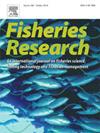在海底拖网中,大小关系到分拣网的效率
IF 2.3
2区 农林科学
Q2 FISHERIES
引用次数: 0
摘要
拖网渔船采用的尺寸选择装置通常受到严格管制,并可在较长时间内保持不变。巴伦支海的gadoid拖网渔业就是这种情况,这是世界上最重要和最有价值的海底渔业之一,自1997年以来,强制性渔具由分类网格和随后的尺寸选择代码组成。在过去的三十年中,该地区通常使用的拖网设备的升级和发展导致了容量问题,这可能导致尺寸选择效率低下和网格部分的操作问题。本研究探讨了通过加倍其分类面积来扩大强制网格是否可以提高渔业的大小选择性。在双拖网配置的海上试验中,直接比较了强制网格段和升级网格段。采用结构模型对数据进行分析,与传统的经验模型相比,该模型更符合两个网格段相对性能的逻辑表示。升级后的网格显著提高了小尺寸黑线鳕(Melanogrammus aeglefinus)的分选效率,而商用尺寸黑线鳕(Gadus morhua)和黑线鳕的捕捞效率相当。升级后的网格所显示的额外分类能力预计将在未来的渔业管理中发挥重要作用。此外,它表明定期修订强制性选择装置的效率的重要性,并可以指出其他有类似问题的渔业采用的方向。升级后的电网并不意味着在运行期间对机组人员有任何额外的工作或挑战。本文章由计算机程序翻译,如有差异,请以英文原文为准。
Size matters for the efficiency of sorting grids in demersal trawls
Size selectivity devices implemented in trawls are often strictly regulated and can remain unchanged over longer periods. This is the case for the Barents Sea gadoid trawl fishery, one of the most important and valuable demersal fisheries in the world, where since 1997 the compulsory gear has been composed of a sorting grid and a subsequent size selective codend. The upscaling and development of the trawl gear typically used in the area in the last three decades has contributed to capacity issues that can lead to inefficiencies in size selectivity and operational problems of grid sections. The present study investigates whether upscaling the mandatory grid by doubling its sorting area can improve the size selectivity in the fishery. A mandatory grid section and an upscaled grid section were directly compared in sea trials in a twin trawl configuration. The data were analyzed considering structural models, which resulted in a more logical representation of the relative performance of the two grid sections compared in the study than traditionally used empirical models. The upscaled grid significantly increased the sorting efficiency for undersized haddock (Melanogrammus aeglefinus), while the catch efficiency of commercial-sized cod (Gadus morhua) and haddock were equal. The additional sorting capacity exhibited by the upscaled grid is expected to play an important role in the future management of the fishery. Further, it demonstrates the importance of revising the efficiency of compulsory selectivity devices periodically and can point to the direction to adopt in other fisheries with similar issues. The upscaled grid did not imply any additional work or challenge for the crew during its operation.
求助全文
通过发布文献求助,成功后即可免费获取论文全文。
去求助
来源期刊

Fisheries Research
农林科学-渔业
CiteScore
4.50
自引率
16.70%
发文量
294
审稿时长
15 weeks
期刊介绍:
This journal provides an international forum for the publication of papers in the areas of fisheries science, fishing technology, fisheries management and relevant socio-economics. The scope covers fisheries in salt, brackish and freshwater systems, and all aspects of associated ecology, environmental aspects of fisheries, and economics. Both theoretical and practical papers are acceptable, including laboratory and field experimental studies relevant to fisheries. Papers on the conservation of exploitable living resources are welcome. Review and Viewpoint articles are also published. As the specified areas inevitably impinge on and interrelate with each other, the approach of the journal is multidisciplinary, and authors are encouraged to emphasise the relevance of their own work to that of other disciplines. The journal is intended for fisheries scientists, biological oceanographers, gear technologists, economists, managers, administrators, policy makers and legislators.
 求助内容:
求助内容: 应助结果提醒方式:
应助结果提醒方式:


